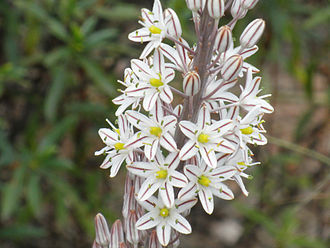Drimia

Drimia is a genus of flowering plants. In the APG IV classification system, it is placed in the family Asparagaceae, subfamily Scilloideae (formerly the family Hyacinthaceae[2]). When broadly circumscribed, the genus includes a number of other genera previously treated separately, including Litanthus, Rhodocodon, Schizobasis and Urginea.[1]
One of the best-known species is the sea squill, Drimia maritima (formerly Urginea maritima). Drimia intricata (formerly Schizobasis intricata) is sometimes cultivated as a bulbous or succulent plant.
Drimia species are usually deciduous, more rarely evergreen, growing from bulbs. The bulbs may be underground or occur on or near the surface. Each bulb has one to several leaves that are often dry by the time the flowers open. The inflorescence is in the form of a raceme, with one to many flowers. At least the lower inflorescence bracts have spurs (a characteristic of the tribe Urgineeae). The individual flowers generally last for only one to two days and have white to yellowish green or brown tepals that are either free or joined into a basal tube. The tepals often have a darker central keel. After fertilization, an ovoid capsule forms with several seeds in each locule. The seeds are black and winged.[3]
A formal description of genus Drimia first appeared in the fourth edition of Species Plantarum, published in 1799, authored by Carl Ludwig Willdenow. The name was attributed to Nikolaus Joseph von Jacquin.[1][4] When describing Drimia elata (the type species of the genus) in a work published in 1797, Jacquin said that he was unable to assign it to one of the known genera, and so constructed a new one. The name is from the Ancient Greek: δριμύς, meaning “bitter” or “acrid”, referring to the root.[5]
The boundaries between genera within the Scilloideae are not completely settled.[3][6] The situation has been described as being in a “state of flux”.[2] As early as 1977, it was suggested that Urginea be merged into Drimia, although other small genera continued to be kept separate. In 2000, Peter Goldblatt and John Charles Manning proposed including other related genera, including Litanthus, Rhadamanthus and Schizobasis, a position supported later by some molecular phylogenetic studies.[3] This broad circumscription of Drimia is accepted by the World Checklist of Selected Plant Families.[1] Other sources prefer to maintain a larger number of segregate genera.[7][8] Regardless of whether a broad or strict view is taken of Drimia, it is placed in the tribe Urgineeae of the subfamily Scilloideae (or the subfamily Urgineoideae of the family Hyacinthaceae if this family is separated from Asparagaceae).[3]
The genus Litanthus was for a long time monotypic, with the sole species L. pusillus, before in 2000 Goldblatt and Manning included it in Drimia.[3] A further species, Drimia stenocarpa, was added to the group in 2014. The Litanthus group is characterized by one- or occasionally two-flowered inflorescences with drooping tubular flowers whose tepals are united at the base for more than half their length.[9]
The genus Rhodocodon was included in Drimia by Goldblatt and Manning in 2000.[3] The species of Rhodocodon, or the Rhodocodon group within Drimia, including D. cryptopoda, form a well supported clade endemic to Madagascar. They appear to be the product of a single invasion of Madagascar by an African species. A total of 13 species are recognized by those who separate the genus from Drimia.[7]
